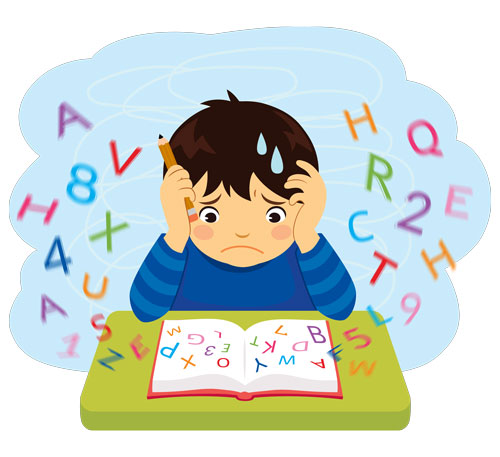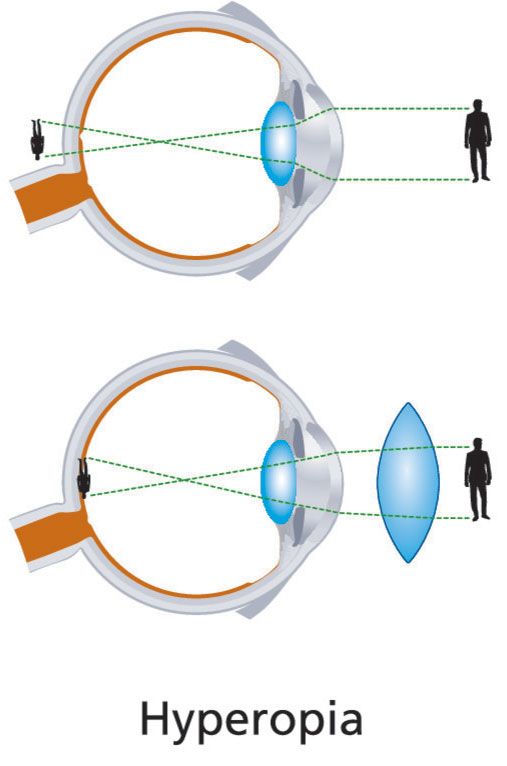 Is your child struggling in school? Are they experiencing unexplained headaches? Don’t jump to conclusions just yet. It turns out that vision problems can often mimic symptoms of ADHD, learning disabilities, tension headaches, and other conditions. In fact, according to the Optometrist Network, children with vision problems are 200% more likely to be diagnosed with ADHD!
Is your child struggling in school? Are they experiencing unexplained headaches? Don’t jump to conclusions just yet. It turns out that vision problems can often mimic symptoms of ADHD, learning disabilities, tension headaches, and other conditions. In fact, according to the Optometrist Network, children with vision problems are 200% more likely to be diagnosed with ADHD!
Misdiagnosis happens more often than you may realize. When vision deficiencies are left undetected, children can experience difficulties with reading, schoolwork, and overall academic success. Fatigue, fidgeting, and frustration may also surface in the classroom, leading to a mistaken diagnosis of ADD/ADHD, dyslexia, or other learning disabilities.
It is estimated that 1 out of 4 children has an undetected vision problem that is interfering with their learning. Early detection and treatment can make all the difference. The simple vision screenings at school or the pediatrician’s office are usually insufficient to detect many children’s problems with eyesight.
Given these statistics, it is not surprising that we regularly see families walk into Lang Family Eye Care confused, frustrated, and ready to give up hope about their child’s issues. We had one such case recently that is a prime example of vision problems related to headaches, reading difficulties, and behavior problems at school. Take a look at Mason’s story and see if any of it sounds familiar to you and your child.
Mason’s Story
Like many families, Alan, Layla, and their son Mason* came in for a routine eye exam before Mason started kindergarten. Both parents were well educated; in fact, Layla is an NP, and Alan is a surgeon at Froedert! Even though they were medical professionals, Alan and Layla missed the subtle signs of vision problems that were interfering with almost every aspect of Mason’s life. They didn’t realize the answer to most of their son’s problems was right before their eyes!
Headaches, two MRIs, a CT, and no answer
Mason started having headaches as a very young child while he was still in preschool. When he started kindergarten, his headaches started getting severe. They tried over-the-counter pain relievers made for severe migraine headaches, but they kept getting worse. Concerned for their son, they sought out a neurologist. The neurologist did multiple MRIs, imaging, and CT scans, but found nothing. Without a diagnosis, they just kept pressing on as best they could.
Reading and behavior issues in first grade
Right around first grade, Mason was starting to have some reading issues. Since his parents both did well in school, they did their best to help him academically with his reading. It never occurred to them that Mason may have vision problems since he had read the wall at his pediatrician’s office with no issues. His distance vision was 20/20; however, his pediatrician failed to check his near vision. It’s common for primary care physicians to be unfamiliar with optometry and vision science and completely overlook signs of farsightedness in children.
The head pain continued
At this point, the family was at their wit’s end. Mason was taking medications for chronic headaches diagnosed by his neurologist. He was assigned a reading specialist at school and spent an hour a day in reading intervention programs. After a year of mysterious reading difficulties, his headaches started to come back. On top of this, his behavior in school was getting worse. He started getting reprimanded for his lack of attention in class. He finally made it through first grade, and there were no problems over the summer.
Vision problems misdiagnosed ADHD
Unfortunately, when school started up again in the fall, so did all of Mason’s issues. Second grade was off to a rough start, so they returned to their primary care pediatrician. He recommended they see a psychiatrist and try ADHD medications. Alan and Layla followed his advice, so they ended up trying a couple of different ADHD medications over the course of four to five months to manage Mason’s behavior.
The answer: bad vision!
During Mason’s second grade year, the family came into Lang Family Eye Care for a basic eye exam. His eyes had never been dilated during previous eye exams, so they completely missed his farsightedness. He had a diagnosis of latent hyperopia, which was manifesting with all these other symptoms and problems. For this family, this diagnosis was truly miraculous.
Fortunately for Mason, his story has a happy ending. He was able to go off of his ADHD medications, and once he got glasses, his headaches went away. His reading caught up to grade level within nine months. He’s in 6th grade now and is a perfectly happy, healthy kid wearing soft contact lenses. Alan and Layla clearly cared about their son, but no amount of addressing the wrong problem will help unless you get to the root cause.
His case is not at all unusual. One of our previous pediatric patients is an engineering student at Marquette University now after extensive reading problems and struggling with math his whole life. His eyes just needed to be dilated! While this is a more extreme case, we get one or two cases of varying degrees every month at Lang Family Eye Care.
What is hyperopia?
 Farsightedness, also known as hyperopia, is a common refractive error affecting how light is refracted in your eye. While most farsighted children have clear distant vision, their near vision may be blurry.
Farsightedness, also known as hyperopia, is a common refractive error affecting how light is refracted in your eye. While most farsighted children have clear distant vision, their near vision may be blurry.
Farsightedness doesn’t affect every child the same way. Some parents may not notice any vision problems, especially when their children are young. It’s important to note that farsightedness is not a disease. It’s simply a disorder in how your eyes focus. When light enters your eye, it should be properly refracted by the cornea and lens to land on the retina at the back of your eye. However, in farsighted individuals, the shape of their eye prevents light from bending correctly, causing it to focus behind the retina. This leads to blurry near vision.
If you are farsighted, this increases the risk that your child will be, as well. However, genetics isn’t the only culprit. There are likely multiple factors at play. In fact, most children are born farsighted, but they don’t experience any significant issues. As they grow older, their eyes naturally change and their farsightedness reduces or disappears.
So, how can you tell if you or your child might have farsightedness? Look out for symptoms similar to what Mason experienced: difficulty with close tasks like reading, eyestrain, squinting, headaches, and even problems paying attention at school.
When you bring your child into Lang Family Eye Care, we will perform various tests to determine his or her visual acuity. For those who can read an eye chart, a phoropter may be used to measure the eyeglass prescription.
While adults usually don’t have complications from untreated hyperopia, children can develop a number of conditions:
- Lazy eye (amblyopia)
- Eyes that aren’t aligned (strabismus)
- Accommodative esotropia (a type of strabismus)
- Developmental delays
The good news is that it’s easily treatable with eyeglasses or contact lenses. These work by refocusing light onto the retina so that you can see clearly. Some children may outgrow farsightedness or not need glasses. Even still, it’s crucial for all children with farsightedness to see an eye doctor to avoid potential problems.
How common are eye problems in children?
Eye problems are surprisingly common in children, even as young as toddlers. Hyperopia (farsightedness) is more common in younger children, whereas myopia (nearsightedness) is more common in older children.
- About 4 percent of preschoolers have myopia, 21 percent have hyperopia, and 10 percent have astigmatism (irregular curvature of the eye), according to a study by the National Institutes of Health.
- Hyperopia is present in 8.4% of children at age six, 2-3% from 9 to 14 years old, and approximately 1% at 15 years old.
- Myopia affects about 5% of preschoolers, 9% of school-aged children, and 30% of adolescents.
What is Attention Deficit Hyperactivity Disorder (ADHD)?
Attention deficit hyperactivity disorder (ADHD) is a prevalent behavioral disorder that predominantly affects children. However, it is not a condition that children simply grow out of. In fact, it often persists into adulthood, causing difficulties at school, home, and in social situations.
While ADHD symptoms can vary widely between children, they generally include excessive daydreaming, frequent forgetfulness or loss of belongings, squirming or fidgeting, excessive talking, making careless mistakes or taking unnecessary risks, struggling to resist temptation, difficulty taking turns, and having trouble getting along with others.
Here are some startling statistics about children diagnosed with ADHD:
- Approximately 6 million children in the US have been diagnosed with ADHD
- About 77% of children diagnosed with ADHD are receiving treatment
- ADHD is more prevalent in males, with a ratio of 3 to 1
- High school graduates with ADHD earn an average of 17% less annual income than their peers
- The average age for an ADHD diagnosis is 7 years old, but severe ADHD is commonly diagnosed even younger
Can vision problems mimic ADHD?
There are an incredible amount of similarities between ADHD and vision problems. Some of these include:
- Attention Issues: When a child lacks visual acuity, simple classroom tasks become overwhelming. This leads to frustration, fatigue, and behavioral problems at school.
- Reading Challenges: Difficulty in eye tracking can make reading a laborious task. Lines of texts may blur, causing discomfort and slower reading rates. This can lead to a perception of a distracted student who lacks focus.
- Impaired Response: It becomes challenging to process visual input and integrate it with other senses. Concentrating on seeing and understanding can make it difficult to respond when addressed directly.
- Careless Mistakes: Rushing through near work can lead to missed details and a lack of attention to detail. Blurry vision, headaches, and eye strain become roadblocks to accuracy.
- Sports Struggles: Functional vision problems transcend the classroom. Judging distance, tracking objects, and following fast-paced activities can be challenging for children with visual impairments.
Poor vision and headaches in children
Mason was a classic example of the problems that farsightedness can cause in children, including headaches. Hyperopia can cause difficulty focusing the eyes. For some children, poor vision can lead to chronic headaches, including severe migraine headaches in more extreme cases.
When we read or perform tasks close up, our eyes naturally move closer together, known as convergence. However, if your child has a condition called convergence insufficiency, their ability to converge their eyes decreases. Convergence insufficiency in children can cause symptoms such as double vision, blurred vision, fatigue, and head pain that mimics a classic tension headache.
Wearing glasses or contacts can alleviate the effort needed to see clearly up close and help reduce or even eliminate headaches. Even if your child does not have headaches, be aware that it is common for children to have mild hyperopia without headaches or other symptoms.
In rare cases, acute infections and inflammatory diseases of the eyes can also cause severe pain in the eyes or head. These conditions are often accompanied by redness of the eye and/or eyelid and light sensitivity. Acute glaucoma can also cause headaches, although this condition rarely affects children. Suppose any signs of these more serious conditions are found in your child. In that case, your Lang Family Eye Care eye doctor may refer you to their pediatrician and/or a neurologist to explore other potential causes.
Vision therapy for ADHD and learning disabilities
Visual skills such as eye tracking, eye teaming, binocular vision, and visual-motor integration play a significant role in learning. Studies have shown that spatial and temporal processing problems can significantly contribute to dyslexia and related learning disabilities in children. If any of these areas are compromised, it can make it difficult for a child to process information effectively.
At Lang Family Eye Care, we frequently refer our patients for vision therapy. This personalized program of evidence-based eye exercises is designed to strengthen visual functions and improve the brain’s interpretation of visual input. Like physical therapy for the eyes, vision therapy can address issues such as lazy eye, eye teaming, focusing, hand-eye coordination, visual perception, and visual tracking.
Results can be seen within a few weeks, but significant improvement usually takes around six months. Every patient is unique, and the length and intensity of therapy will vary. Lang Family Eye Care has trusted partnerships in the Waukesha, New Berlin, and Milwaukee area and will refer your child to a visual therapy provider if needed.
How do I know if my child’s headaches, reading difficulties, or behavior problems are vision-related?
Your child’s vision problems may display different symptoms depending on their age. If your child is experiencing any of these symptoms, you should consider bringing them in for an eye exam:
Children ages 4-9:
- Poor athletic coordination
- Bad handwriting
- Reading problems
- Putting screens close to their face
- Difficulty seeing the board in class
- Being clumsy
- Headaches
- Light sensitivity
- Squinting or covering one eye to see
Children ages 9-13:
- Headaches and nausea
- Bumping into objects
- Difficulty reading
- Light sensitivity
- Sitting close to the computer screen
- Eye fatigue
- Difficulty reading the board in class
- Frequent blinking
Teenagers 14 years and older:
- Headaches
- Reading and learning difficulties
- Problems focusing in class
- Nausea
- Sensitivity to light
- Difficulty with sports (catching/hitting balls)
- Neck pain
- Tilting the head
Learn from Mason: Get your child screened for vision problems early
While all of your child’s learning or behavior problems may not be cured with a simple pair of glasses, you would be amazed at how much proper vision will improve their quality of life. At Lang Family Eye Care, we have seen countless children and adults with mysterious migraine headaches, reading problems, and difficulty concentrating that all stemmed from poor vision. Avoid wasting time, money, and stress trying to solve the wrong problem. Our caring Lang Family Eye Care eye doctors make children’s eye exams fun and painless (there are even games involved!), so there’s no harm in getting them checked early. You never know—it could be the hidden solution you’ve been missing!
*Names have been changed for patient privacy.
Want to have your child's vision checked?
We always welcome new patients. Call or text us today to schedule an appointment or Request an Appointment Online.
Share this article:

